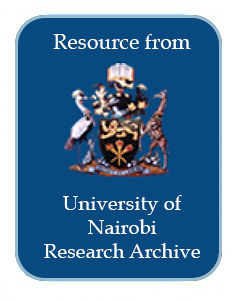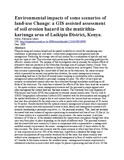Location
Our Vision is to be a world-class university committed to scholarly excellence.
Our Mission is to provide quality university education and training and to embody the aspirations of the Kenyan people and the global community through creation, preservation, integration, transmission and utilization of knowledge.
Core Values
In order to realize the above vision and mission, certain shared values shall be nurtured. There is great need for the University to be guided by the right values derived from the virtues and moral standards of the Kenyan and wider society.
Core Functions
Teaching and Learning: The university offers innovative , relevant and market driven academic programmes , both at undergraduate and postgraduate levels with inbuilt quality control systems the university also provides an environment and policy framework for undertaking high quality and relevant research
Members:
Resources
Displaying 226 - 230 of 298Essays on land law: the reform debate in Kenya.
The various legal, political, economic and social perspectives that have influenced the land reform discourse in Kenya are examined. The historical perspectives of the land question in Kenya are outlined, and the factors that shaped the content of Kenya's land law and attendant institutional and constitutional regimes are addressed. The operationalization of the legal regimes and policy frameworks emergent from the colonial legacy is also extensively dealt with, focusing on the way the state has sought to balance private and public interests in land through the instruments of law.
Environmental impacts of some scenarios of land-use Change: a gis assisted assessment of soil erosion hazard in The Mutirithia-Kariunga area of Laikipia District, Kenya.
Characterizing soil erosion hazard and its spatial variability is critical for maintaining
user confidence in planning soil- and water- conservation programmes and general
land-use management. Predicting the average rates of soil erosion for a combination
of specific soil and land-use types is vital. This is because such predictions form a
basis for providing guidelines for effective erosion control.
The purpose of this investigation was to examine the erosion effects of alternative
Land use and land cover changes in the greater Amboseli ecosystem, Kajiado District, Kenya between 1988 and 1998.
For millenia, Greater Amboseli ecosystem of Kenya has had a central role in subsistence
pastoralism and wildlife conservation by providing vast biological resources for pastoralists and
their livestock; and habitat for wildlife. Recently, with the creation of Amboseli National Park
and rapid changes in land tenure systems, the human use of the ecosystem has intensified. This
change has shaped a pastoral landscape composed of livestock grazing, wildlife conservation,
Land and water management in Kenya: towards sustainable land use.
Preliminary findings on the effects of land use in the Masinga Dam catchment, Kenya, on the storage capacity of the reservoir are presented. Remote sensing and GIS techniques, supplemented with ground reports, were used to determine areas most susceptible to erosion. A representative catchment was then chosen for rainy season monitoring of soil loss, river suspended sediments and discharge response to rainfall. In addition, Gerlach-type traps were used to evaluate erosion rates under different crop covers and slope gradients.



